
Sustainable design has made great strides in recent years; unfortunately, it still falls short of fully integrating nature into our built environment. Through a groundbreaking new paradigm of "restorative environmental design," award-winning author Stephen R. Kellert proposes a new architectural model of sustainability.
In Building For Life, Kellert examines the fundamental interconnectedness of people and nature, and how the loss of this connection results in a diminished quality of life.
This thoughtful new work illustrates how architects and designers can use simple methods to address our innate needs for contact with nature. Through the use of natural lighting, ventilation, and materials, as well as more unexpected methodologies-the use of metaphor, perspective, enticement, and symbol-architects can greatly enhance our daily lives. These design techniques foster intellectual development, relaxation, and physical and emotional well-being. In the works of architects like Frank Lloyd Wright, Eero Saarinen, Cesar Pelli, Norman Foster, and Michael Hopkins, Kellert sees the success of these strategies and presents models for moving forward. Ultimately, Kellert views our fractured relationship with nature as a design problem rather than an unavoidable aspect of modern life, and he proposes many practical and creative solutions for cultivating a more rewarding experience of nature in our built environment.


Prince shows that many choices about camera position, editing, and blocking of the action and sound were functional responses by filmmakers to regulatory constraints, necessary for approval from the PCA and then in surviving scrutiny by state and municipal censor boards.
This book is the first stylistic history of American screen violence that is grounded in industry documentation. Using PCA files, Prince traces the negotiations over violence carried out by filmmakers and officials and shows how the outcome left its traces on picture and sound in the films.
Almost everything revealed by this research is contrary to what most have believed about Hollywood and film violence. With chapters such as "Throwing the Extra Punch" and "Cruelty, Sadism, and the Horror Film," this book will become the defining work on classical film violence and its connection to the graphic mayhem of today's movies.

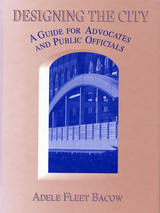
Written in a clear and engaging style, Designing the City is a practical manual for improving the way communities are planned, designed, and built. It presents a wealth of information on design and decision-making, including advice on how citizens and activists can make their voices heard, and numerous examples of effective strategies for working with all parties involved in neighborhood and community development. It highlights proven models and strategies to help communities:
- establish unique and productive partnerships with public works and transportation departments
- develop resources through grant programs
- broaden expertise, perspective, and constituency
- create new and enduring models for effective action
- educate participants and consumers of the design and development process
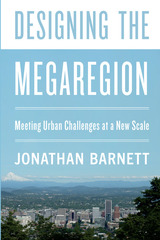
In Designing the Megaregion, planning and urban design expert Jonathan Barnett describes how to redesign megaregional growth using mostly private investment, without having to wait for massive government funding or new governmental structures. Barnett explains practical initiatives to make new development fit into its environmental setting, especially important as the climate changes; reorganize transportation systems to pull together all the components of these large urban regions; and redirect the market forces which are making megaregions very unequal places.
There is an urgent need to begin designing megaregions, and Barnett shows that the ways to make major improvements are already available.
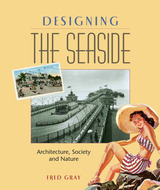
Surprisingly, the common notion of taking a seaside vacation has only existed since the eighteenth century, with a growing acceptance of the idea that fresh air and sea water are good for one’s health. Since then, seaside resorts for all budgets have sprung up around the world. In Designing the Seaside, Fred Gray offers a richly illustrated history of seaside architecture and culture, from the smallest beach hut to the grandest hotels. Through over 400 illustrations that include historic photographs, pamphlets, guidebooks, postcards, and posters, Gray explores the changing attitudes toward shoreline vacations.
“Designing the Seaside manages to be both scholarly and colorful and offers a timely history of seaside art and architecture, from Brighton Pier and beach huts in Nice to a derelict resort complex in the Baltic, to the bizarre Palm islands of Dubai.”—London Evening Standard
“Filled with photographs, architectural drawings, guidebooks, postcards and posters, this book explores changing attitudes to holidays and their settings. . . . There is an exploration of how the seaside became a hotbed for issues of morality, where people took their sauce on a postcard as often as with their fish and chips.”—Daily Telegraph
“Gray’s illuminating study of the history of seaside architecture shows what a profound influence many of the innovations born on British coasts have had on Western holiday ideals.”—Metro London
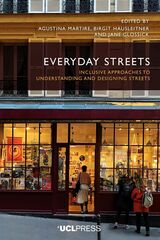
Everyday streets are both the most used and most undervalued of cities’ public spaces. They are places of social aggregation, bringing together people of different classes, genders, ages, ethnicities, and nationalities. They comprise not just the familiar outdoor spaces that we move through and interact in but also urban blocks, interiors, depths, and hinterlands, which are integral to streets’ nature and contribute to their vitality. Everyday Streets offers an inclusive approach to understanding and designing these streets through an analysis of them as found in cities around the globe. From the regular rectilinear urban blocks of Montreal to the carefully regulated narrow alleyways of Naples, and from the resilient market streets of London to the crammed commercial streets of Chennai, the streets in this book were all conceived with a certain level of control. Everyday Streets is a palimpsest of methods, perspectives, and recommendations that together provide a solid understanding of everyday streets, their degree of inclusiveness, and to what extent they could be more inclusive.

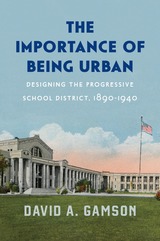
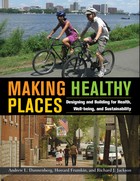
This book provides a far-reaching follow-up to the pathbreaking Urban Sprawl and Public Health, published in 2004. That book sparked a range of inquiries into the connections between constructed environments, particularly cities and suburbs, and the health of residents, especially humans. Since then, numerous studies have extended and refined the book's research and reporting. Making Healthy Places offers a fresh and comprehensive look at this vital subject today.
There is no other book with the depth, breadth, vision, and accessibility that this book offers. In addition to being of particular interest to undergraduate and graduate students in public health and urban planning, it will be essential reading for public health officials, planners, architects, landscape architects, environmentalists, and all those who care about the design of their communities.
Like a well-trained doctor, Making Healthy Places presents a diagnosis of--and offers treatment for--problems related to the built environment. Drawing on the latest scientific evidence, with contributions from experts in a range of fields, it imparts a wealth of practical information, with an emphasis on demonstrated and promising solutions to commonly occurring problems.
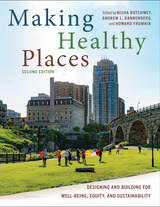
In Making Healthy Places, Second Edition: Designing and Building for Well-Being, Equity, and Sustainability, planning and public health experts Nisha D. Botchwey, Andrew L. Dannenberg, and Howard Frumkin bring together scholars and practitioners from across the globe in fields ranging from public health, planning, and urban design, to sustainability, social work, and public policy. This updated and expanded edition explains how to design and build places that are beneficial to the physical, mental, and emotional health of humans, while also considering the health of the planet.
This edition expands the treatment of some topics that received less attention a decade ago, such as the relationship of the built environment to equity and health disparities, climate change, resilience, new technology developments, and the evolving impacts of the COVID-19 pandemic.
Drawing on the latest research, Making Healthy Places, Second Edition imparts a wealth of practical information on the role of the built environment in advancing major societal goals, such as health and well-being, equity, sustainability, and resilience.
This update of a classic is a must-read for students and practicing professionals in public health, planning, architecture, civil engineering, transportation, and related fields.
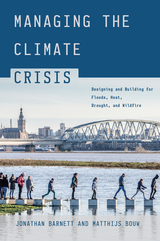
In Managing the Climate Crisis, design and planning experts Jonathan Barnett and Matthijs Bouw take a practical approach to addressing the inevitable and growing threats from the climate crisis using constructed and nature-based design and engineering and ordinary government programs. They discuss adaptation and preventive measures and illustrate their implementation for seven climate-related threats: flooding along coastlines, river flooding, flash floods from extreme rain events, drought, wildfire, long periods of high heat, and food shortages.
The policies and investments needed to protect lives and property are affordable if they begin now, and are planned and budgeted over the next 30 years. Preventive actions can also be a tremendous opportunity, not only to create jobs, but also to remake cities and landscapes to be better for everyone. Flood defenses can be incorporated into new waterfront parks. The green designs needed to control flash floods can also help shield communities from excessive heat. Combating wildfires can produce healthier forests and generate creative designs for low-ignition landscapes and more fire-resistant buildings. Capturing rainwater can make cities respond to severe weather more naturally, while conserving farmland from erosion and encouraging roof-top greenhouses can safeguard food supplies.
Managing the Climate Crisis is a practical guide to managing the immediate threats from a changing climate while improving the way we live.
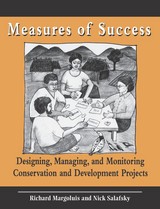
Measures of Success is a practical, hands-on guide to designing, managing, and measuring the impacts of community-oriented conservation and development projects. It presents a simple, clear, logical, and yet comprehensive approach to developing and implementing effective programs, and can help conservation and development practitioners use principles of adaptive management to test assumptions about their projects and learn from the results.
The book presents a systematic approach to improving the focus, effectiveness, and efficiency of projects, with specific guidelines and advice on:
- designing a realistic conceptual framework based on local site conditions
- developing clearly defined goals, objectives, and activities
- creating a monitoring plan that can be used to assess whether goals and objectives are being met
- integrating social and biological science techniques to collect the most relevant and useful data in the most cost-effective way
- using the information obtained through the monitoring plan to modify the project and learn from the result
The text is developed in eight chapters that follow the structure of a planning process from conception to completion, with the chapters linked by four scenarios that serve as teaching case studies throughout the book. Examples from these scenarios illustrate the processes and tools discussed, and each scenario case study is presented in its entirety in an appendix to the volume. The approach has been developed and field tested by practitioners working in many different projects in Latin America, Africa, and Asia, and their experience and input ensure that the guide is both practical and useful.
Measures of Success is the only work of its kind currently available, and represents an invaluable resource for field-based practitioners, project managers, and local community leaders, as well as for international NGO staff, college and university teachers and students, researchers, and government officials.
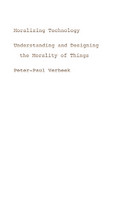
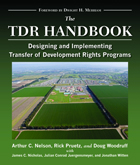
Although TDR programs must conform to zoning laws, they provide market incentives that make them more equitable (and often more lucrative) for sellers and frequently benefit buyers by allowing them to receive prior approval for their high-density development plans. Since the 1970s when modern TDR applications were first conceived, more than 200 communities in 33 states across the U.S. have implemented TDR-based programs. The most common uses of TDR to date involve protecting farmland, environmentally sensitive land, historic sites, and "rural character," and urban revitalization.
Until now, however, there has never been a clearly written, one-volume book on the subject. At last, The TDR Handbook provides a comprehensive guide to every aspect of TDR programs, from the thinking behind them to the nuts and bolts of implementation-including statutory guidance, model ordinances, suggestions for program administration, and comparisons with other types of preservation programs. In addition, six of its twenty chapters are devoted to case studies of all major uses to which TDR programs have been utilized to date, including recent urban revitalization projects that utilize TDR principles.
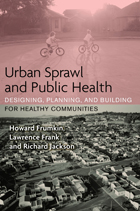
In Urban Sprawl and Public Health, Howard Frumkin, Lawrence Frank, and Richard Jackson, three of the nation's leading public health and urban planning experts explore an intriguing question: How does the physical environment in which we live affect our health? For decades, growth and development in our communities has been of the low-density, automobile-dependent type known as sprawl. The authors examine the direct and indirect impacts of sprawl on human health and well-being, and discuss the prospects for improving public health through alternative approaches to design, land use, and transportation.
Urban Sprawl and Public Health offers a comprehensive look at the interface of urban planning, architecture, transportation, community design, and public health. It summarizes the evidence linking adverse health outcomes with sprawling development, and outlines the complex challenges of developing policy that promotes and protects public health. Anyone concerned with issues of public health, urban planning, transportation, architecture, or the environment will want to read Urban Sprawl and Public Health.
READERS
Browse our collection.
PUBLISHERS
See BiblioVault's publisher services.
STUDENT SERVICES
Files for college accessibility offices.
UChicago Accessibility Resources
home | accessibility | search | about | contact us
BiblioVault ® 2001 - 2024
The University of Chicago Press









